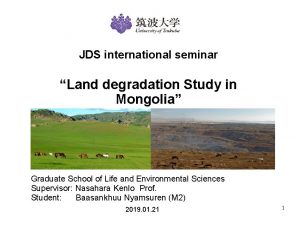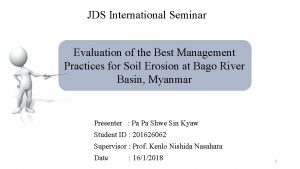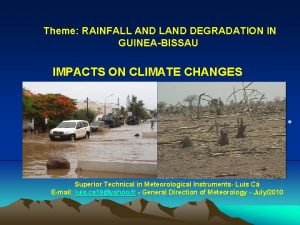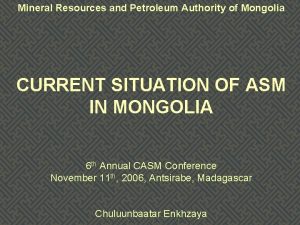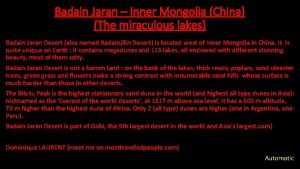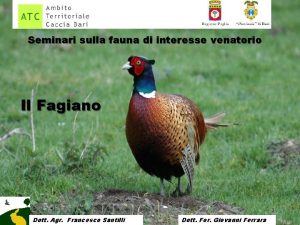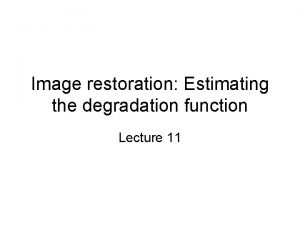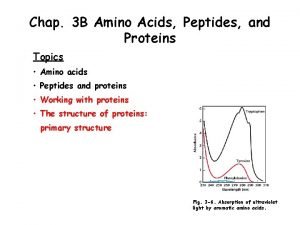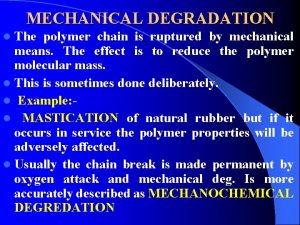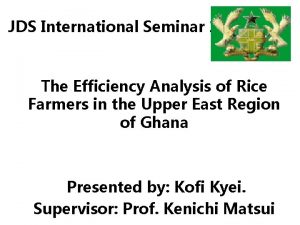JDS international seminar Land degradation Study in Mongolia













- Slides: 13

JDS international seminar “Land degradation Study in Mongolia” Graduate School of Life and Environmental Sciences Supervisor: Nasahara Kenlo Prof. Student: Baasankhuu Nyamsuren (M 2) 2019. 01. 21 1

Land cover types of Mongolia Forest Grassland Desert Mongolia is the landlocked country. Total area is approximately 1, 565, 000 square km. Located in the convergence of Siberian forest biomes, Central Asian steppe, Gobi deserts. Source: http: //www. eic. mn/land/gis. php 2

Land Degradation in Mongolia Climate change - Drought Human Induced activities - Mining operations (77649. 45 hec) - https: //news. un. org/en/story - Desertification (76. 9% area) http: //zamineservices. com/ - Overgrazing (66. 2 million) 3 https: //montsame. mn/en/read/130466 https: //twitter. com/UNDPMongolia/status

プ レ ゼ ン タ ー Remote sensing Vegetation dynamic 2019 -01 -20 13: 53: 34 ----------------------After come to japan My supervisor advised me to use GPM satellite for vegetation analyse. Now I would like to introduce about GPM satellite Designed to observe Earth’s precipitation http: //www. surf-forecast. com/breaks/El-Mongol Survey mapping - High cost - Limited coverage area - Human labor intervention Satellite mapping - Low cost - Large coverage area - Less labor intervention - Continuously mapping Research now : 1. Try to develop new method for vegetation from active radar 2. Analyze vegetation to detect the land degradation 4

Joint Mission of NASA and JAXA GPM Circular, non-sunsynchronous Orbit: Launched date: 2014. Feb. 28 Launch mass: 3850 kg Power: 1950 W The GPM mission dedicated to observe the global precipitation. Inclination angle: 65° 5

Precipitation Measurement Missions GPM – Global Precipitation Measurement, launched 2014. Feb Images source: https: //pmm. nasa. gov/gpm 6

GPM Instruments Build on success of TRMM Designed life: 5 years GPM Microwave Imager (GMI) - Passive sensor installed from NASA. - Multi-channel, conical scanning, 13 channels 10 GHz – 183 GHz - Sense to total precipitation within all cloud layers Dual-frequency Precipitation Radar (DPR) - Active sensor developed from JAXA. - Consist of Ka-band PR, Ku-band PR. - Ku-band measure moderate-to-heavy rain - Ka-band measure frozen precipitation and light rain - Ku/Ka-band provide rain drop size distribution in the cloud. 7

DPR/ Ku and Ka band radar signal Vegetation Characteristics Without precipitation condition radar signals retrieve the information about the land surface. Incidence angle Ku band ± 17 degree, Ka band ± 8. 5 degree scanning. Normalized radar cross section (NRCS) backscattered values were used for the calculation. 8

Comparison with Precipitation and MODIS/LAI Based on map derived from ESA CCI 2015 Landcover map: The Seasonal variation of: (2014 -2017) ● MCD 15 A 3 H MODIS Leaf Area Index/FPAR data ● The precipitation data of meteorological stations were used In order to compare with the Ku and Ka band backscattered values. 9

NRCS backscattering from the Forest Incidence angle dependency: Seasonal variation: 10

NRCS backscattering from the Grass Incidence angle dependency: Seasonal variation: 11

NRCS backscattering from the Desert Incidence angle dependency: Seasonal variation: 12

Thank you for your attention…
 Jds mongolia
Jds mongolia Jds international
Jds international Land degradation definition
Land degradation definition Normalization using fd mvd and jds
Normalization using fd mvd and jds Mineral resources and petroleum authority of mongolia
Mineral resources and petroleum authority of mongolia Twin lakes mongolia
Twin lakes mongolia Kublai khan accomplishments
Kublai khan accomplishments City university mongolia
City university mongolia Cambulac mongolia
Cambulac mongolia Fagiano mongolia
Fagiano mongolia Estimation of degradation function
Estimation of degradation function Purification table
Purification table Final product of purine degradation
Final product of purine degradation Mechanical degradation
Mechanical degradation
